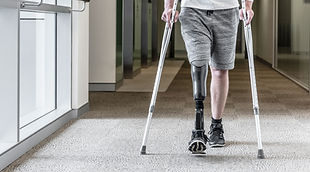

Back Pain
Physiotherapy is a treatment that helps to improve the movement and function of joints and muscles. It can help to reduce back pain and get you get moving normally again. It can also help to reduce the risk of hurting your back again. Physiotherapists use many treatments and techniques to help with back pain. They also offer advice on looking after your back.
Home / Conditions / Back Pain

Why would I need physiotherapy for back pain?
If you have back pain that’s causing significant problems or doesn’t get better after a few weeks, it could be worth seeing a physiotherapist. Physiotherapy can be useful for different types of back pain. It may help with the following.
-
Non-specific lower back pain – where no cause (such as an underlying medical condition or injury) has been identified.
-
Sciatic pain – this spreads from your back down your legs and may be caused by a prolapsed disc (when a disc in your spine bulges out of its normal shape and presses on a nerve).
-
Back pain caused by ageing of the discs in your spine (degenerative disc disease).
-
Spinal stenosis – when the space around your spinal cord narrows, putting pressure on your spinal cord and causing pain.
Your GP may refer you to a physiotherapist or you can arrange an appointment yourself. For more information on this, see our section on finding a physiotherapist below.
Your GP or physiotherapist may recommend physiotherapy as part of a treatment package that includes hands-on manual therapy, an exercise programme, painkillers and psychological support. Having a combination of treatments like this may give you the best chance of getting rid of your back pain. Your physiotherapist will also help you to understand what’s causing your pain so you can take steps to manage it.

What will happen when I see a physiotherapist?
When you first see a physiotherapist, they’ll take a detailed medical history. They’ll ask you about any medical conditions you have, your lifestyle, your work environment and any medications you take. They’ll also want to know what symptoms you’ve had, and what tends to trigger them. Next, they’ll do a detailed physical examination, including looking at how you move and how your back is working. They may also do a neurological assessment to see how well your nerves are working. You may need to remove some clothes when you go for physiotherapy, so that your physiotherapist can see and feel your back. You can ask to have a chaperone if you prefer.
Your physiotherapist will explain the treatment they recommend, and how they expect this to help your back pain. They should also warn you about any potential risks of the treatment. If you’re unsure about anything, don’t be afraid to ask. It’s important that you fully understand what your physiotherapist is recommending because you’ll be asked to give your consent to go ahead with treatment.

Exercise and Manual Therapy
Aerobic exercise
This is any exercise that gets you moving and increases your heart rate. It is the most important part of any treatment programme. Aerobic exercise can help with any stiffness you may have and will keep you mobile. It will also help to manage your weight and can give your wellbeing a boost. Your physiotherapist may recommend low-impact aerobic exercises to start with; these include walking, swimming, and using exercise bikes and step machines. They’ll encourage you to do more as you feel able. They will probably advise aerobic exercise for 20 to 30 minutes, up to 5 times a week. But you may need to start with shorter periods.
Stretching exercises
Stretching improves flexibility in your spine and reduces tension in the muscles supporting your spine. You usually do these exercises every day. A typical stretching exercise is to lie on your back and pull your knees up towards you to gently stretch your back. Or, standing and bending forward to stretch your hamstring muscles in the backs of your legs. This can reduce stress in your lower back.
Strengthening exercises
Exercises to strengthen core muscles can sometimes be a part of exercise programmes for back pain. Your core muscles are the abdominal muscles around your stomach, the muscles in your back, and those around your pelvis. These exercises can be helpful in the short term. But there’s growing evidence that core exercises are no more helpful than general exercise in the long term. So, this may not be something your physiotherapist focuses on. Being active in general is more important.
Manual therapies
Your physiotherapist may also suggest trying one of the following manual (hands on) techniques. This will always be alongside an exercise programme.
-
Mobilisation means your physiotherapist will use slow, gentle movements to stretch your spine. The aim is to return your back to its normal range of motion.
-
Manipulation means your physiotherapist will make quick thrusting movements with their hands at a particular point of your spine. You might hear a ‘pop’ sound when they do this.
Physiotherapists used to offer other treatments such as transcutaneous electrical nerve stimulation (TENS) and acupuncture. But these treatments are not recommended in guidelines for back pain because there’s not enough evidence that they help yet. Massage is another therapy where there is little evidence for how well it works. It may be used for treatment of low back pain, but only alongside an exercise programme.
_edited.png)





